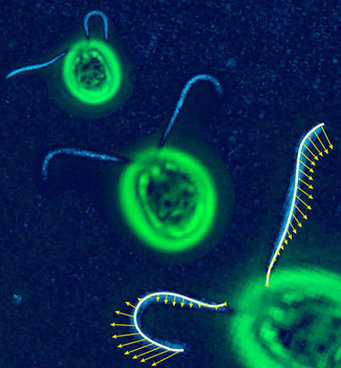Green algae move to the beat
Max Planck researchers in Dresden explain the flagellar synchronisation of swimming algae

“An alga is a wonderful model for investigating our research question because, with its two flagella, it shows us very clearly how several of these appendage-like structures are synchronised using mechanical forces alone,” says Benjamin Friedrich from the Max Planck Institute for the Physics of Complex Systems who headed the studies. How tens of thousands of molecular engines work together to set flagella in motion and synchronise them is a matter of great interest, as this mechanism underlies numerous processes: “The tiny cellular appendages are one of nature’s greatest hits: they drive sperm and form big conveyor belts in the fallopian tubes and airways,” explains Friedrich.
The cellular extensions, which are a mere ten micrometres long, beat around 30 times per second. In a flat observation chamber, the researchers allowed the single-celled green algae Chlamydomonas to swim around under their microscope lenses and then evaluated the swimming and bending movements on the microscope films: “From these films, we are able to reconstruct all of the mechanical forces at work in detail,” says Friedrich. When the load increases, the flagellum beats more slowly – just like a car engine that has to negotiate an incline. The strength and speed of the beat are linked to the movement of the body. This load dependency synchronises the beats of the two flagella and thus eliminates the need for special sensors or chemical signals.
FF/HR
